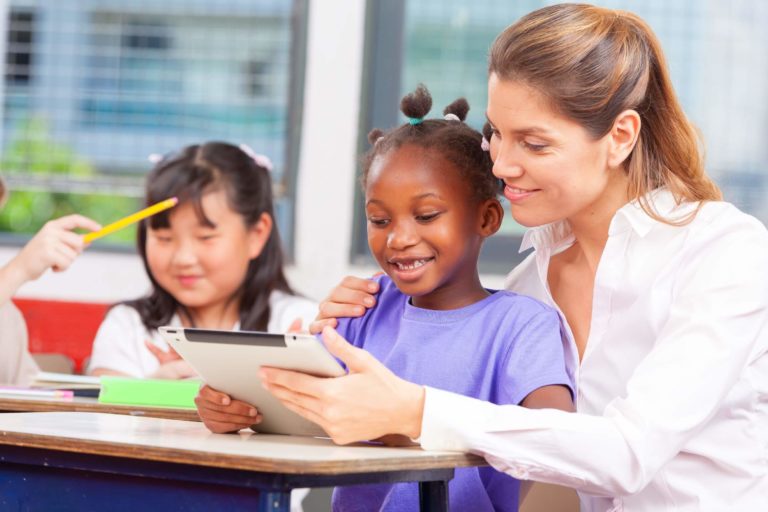Entering a classroom nowadays looks pretty different than it did a decade ago. Computers, iPads, and Smartboards are becoming just as common as pencils, papers, and books. In today’s classrooms, technology has become an essential part of education. While screen time can offer numerous benefits, it is also important to strike the right balance to ensure a healthy learning environment.
Why Screen Time is Important in the Classroom
It’s important to understand the difference between “screen time” spent playing video games and scrolling TikTok and “educational screen time” where students are learning. When screen time is used for educational purposes, it can positively impact a child’s development and can enhance their learning as long as it’s not excessive, says an updated 2023 review on the Effects of Excessive Screen Time on Child Development.
How much technology you use in the classroom should depend upon the age of the students and the purpose of the screen use. Screen time can have many benefits and help learners complete tasks they may have not been able to if not using technology, such as the ability to adapt to students’ individual needs and learning styles. It also can provide an engaging learning experience that captures student’s attention, which can lead to an increase in understanding and retention. In addition, screen time exposes students to technology they may need in their future careers. Becoming familiar with these digital tools now will only help prepare them for their future.
Rules About Screen Time Usage in the Classroom
There’s no denying that students are using their smartphones in the classroom, even if it’s against school policy. According to research conducted by Common Sense Media students on average use their smartphones for 43 minutes a day during school hours and pick up their phones about 72-500 times per day. In addition to the permitted screen time allocated in the classroom, incorporating this may result in an excessive amount of screen exposure.
According to the U.S. National Library of Medicine, too much screen time can cause sleep disturbances, anxiety, depression, attention issues, and obesity. With this increase in screen time, it’s necessary to establish rules and guidelines for students to adhere to while in the classroom. Here are a few ideas on how to guide students on appropriate screen time usage in the classroom.
- Distinguish between active and passive screen time. Active screen time involves educational engagement, leading to positive effects, whereas passive screen time revolves around entertainment, potentially resulting in adverse effects.
- Clearly communicate your expectations about technology to help foster a positive learning environment.
- Implement time limits to prevent overexposure to screens.
- Only use technology as a tool to enhance instruction, not to replace instruction.
- Educate students about responsible choices with their screen time to help them develop self-regulation skills.
Alternative Teaching Styles that Do Not Use Technology
Technology can be a powerful and valuable tool to use in the classroom. However, there are alternative teaching methods that do not rely on technology. Here are a few teaching styles that emphasize hands-on learning, collaboration, or creative expression.
Cooperative Learning
Cooperative learning is a structured teaching strategy where students work together in a group and participate equally to complete a task. This alternative teaching style fosters teamwork, communication, and social skills without relying on technology. Educators like using this teaching method because it tends to boost student motivation and participation.
Project-Based Learning
Project-based learning or PBL is a student-centered, teacher-facilitated learning method where students work on a project over an extended time. It involves students actively engaging in a complex and authentic real-world problem or challenge. This approach builds 21st-century skills such as critical thinking and problem-solving skills without heavily relying on technology.
Montessori Method
The Montessori method is a self-directed hands-on approach to learning where students are encouraged to work at their own pace. Learning practical life skills and understanding different cultures are integral to this method of learning. Social development is also a fundamental aspect of this approach as well as the freedom for students to choose their own activities.
Experiential Learning
Experiential learning can serve as an alternative to using technology in the classroom because instead of using digital tools, this approach relies on hands-on learning and as well as using real-world experiences. Through active participation, collaboration, and personalized learning, students cultivate a love for learning without the need for screens.
Traditional Teaching Methods
Traditional methods that have been employed for decades, such as lectures, class discussions, group activities, non-digital games, chalkboard instruction, using textbooks or novels, role-playing, and using visual aids, continue to be an effective way to convey information and deepen understanding of concepts.
While technology can provide students with engaging and meaningful learning experiences, educators need to be in the know about screen time. It’s essential to be conscious about your media choices to ensure you’re using screen time purposefully and only to enhance student learning, not replace it. By establishing guidelines for your students and yourself to follow when using digital tools, you can make screen time a positive learning experience for students.
Educational Resources for Both School and Home
Here are a few resources to help reinforce screen time balance at both school and home.
Digital Learning Contract
Students can sign a digital learning agreement to pledge to be a responsible and respectful digital learner. Here are a few contracts from Common Sense Media.
- Digital Learning Pledge for Grades K-5
- Digital Learning Pledge for Grades 6-12
- Digital Learning Pledge for Home
Resources for Educators
- Digital Citizenship Curriculum
- Free multimedia curriculum materials from The Media Education Lab
- Screen Time & Activity Finding the Balance
- Children and Screens: Interdisciplinary research and essential information on digital media and child development




